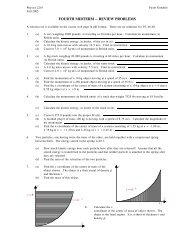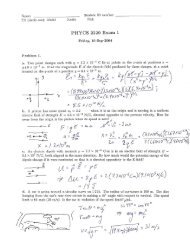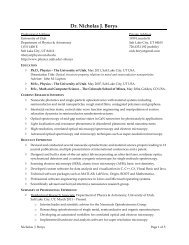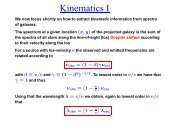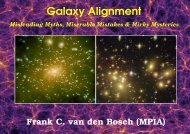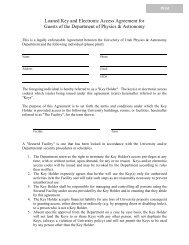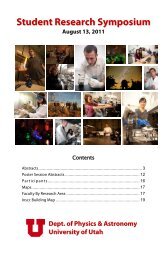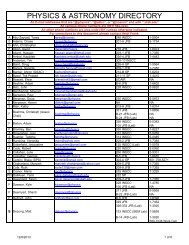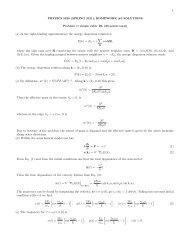PHYS 3410/3411/6750/6751: Modern Optics I & II - Department of ...
PHYS 3410/3411/6750/6751: Modern Optics I & II - Department of ...
PHYS 3410/3411/6750/6751: Modern Optics I & II - Department of ...
Create successful ePaper yourself
Turn your PDF publications into a flip-book with our unique Google optimized e-Paper software.
<strong>PHYS</strong> <strong>3410</strong>/<strong>3411</strong>/<strong>6750</strong>/<strong>6751</strong>:<br />
<strong>Modern</strong> <strong>Optics</strong> I & <strong>II</strong><br />
The University <strong>of</strong> Utah<br />
<strong>Department</strong> <strong>of</strong> Physics and Astronomy<br />
Fall Semester 2012<br />
Course website: http://www.physics.utah.edu/~bolton/optics/<br />
Instructor: Pr<strong>of</strong>. Adam S. Bolton<br />
Email: bolton@astro.utah.edu<br />
Phone: 801-585-5383<br />
Campus mailing address: 115 South 1400 East (JFB 201)<br />
Office: INSCC 468 (inside the INSCC 452 suite)<br />
Office hour: Thursdays 11:00 AM – 12:00 noon<br />
Lecture time and location: Mondays and Wednesdays, 1:25–2:45 PM, JFB B-1<br />
Recommended prerequisite: <strong>PHYS</strong> 2220 or equivalent<br />
(Physics for Scientists and Engineers)<br />
Textbook: “<strong>Optics</strong>” by Eugene Hecht (4th Edition). This textbook can be purchased at<br />
the campus bookstore. The Marriott Library will also have a few copies on reserve.<br />
Course description: This course will cover classical geometric optics; the electromagnetic<br />
and quantum mechanical foundations <strong>of</strong> optical phenomena; wave optics; and an introduction<br />
to modern optical systems including lasers. Most chapters <strong>of</strong> the textbook will be covered,<br />
roughly in sequence, over the course <strong>of</strong> the semester.<br />
Laboratory sections: The associated laboratory sections provide hands-on experience with<br />
the phenomena presented in lectures. Concurrent enrollment in one <strong>of</strong> the lab sections is<br />
mandatory. Further information on organization and grading within the labs will be provided<br />
at the initial lab meetings.<br />
Important dates:<br />
Monday 20 August 2012: First day <strong>of</strong> class<br />
Tuesday 28 August through Friday 31 August 2012: Introductory laboratory meetings<br />
Wednesday 03 October 2012: First mid-term examination<br />
Week <strong>of</strong> 08–12 October 2012: Fall Break (no classes)<br />
Wednesday 14 November 2012: Second mid-term examination<br />
Week <strong>of</strong> 19–23 November 2012: No lab meetings (due to Thanksgiving break)<br />
Wednesday 05 December 2012: Final lecture (labs continue through Friday 07 December)<br />
Friday 14 December 2012, 1:00PM-3:00PM: Final exam
<strong>PHYS</strong> <strong>3410</strong>/<strong>3411</strong>/<strong>6750</strong>/<strong>6751</strong>: <strong>Modern</strong> <strong>Optics</strong> I & <strong>II</strong>, Fall 2012 2<br />
Grading:<br />
15% quizzes<br />
20% mid-term examinations<br />
30% final examination<br />
35% lab grade<br />
Problem sets and quizzes: Homework problems will be assigned during most weeks,<br />
primarily from the textbook. Generally, these assignments will be posted in PDF form to<br />
the class website before the start <strong>of</strong> class on Monday. One week following the assignment <strong>of</strong><br />
problems, there will be a 10-minute quiz at the start <strong>of</strong> Monday’s class consisting <strong>of</strong> one <strong>of</strong><br />
the homework problems (with possible minor modifications). The lowest two quiz grades will<br />
be dropped when determining your quiz grade for the term. Those enrolled at the graduate<br />
level (<strong>6750</strong>) will usually have a few more advanced problems assigned in addition to the<br />
problems assigned to undergraduates.<br />
Mid-terms: There will be two mid-term examinations. For students enrolled at the undergraduate<br />
level (<strong>3410</strong>), the lower <strong>of</strong> the two mid-term scores will be dropped when computing<br />
the term grade. Students enrolled at the graduate level (<strong>6750</strong>) will have both mid-term<br />
grades used in the computation <strong>of</strong> their term grade.<br />
Final examination: There will be a final exam on Friday 14 December 2012. Students<br />
enrolled at the graduate level (<strong>6750</strong>) may be given additional, more advanced problems on<br />
the final.<br />
Lab section coordinator: Pr<strong>of</strong>. Gernot Laicher<br />
(phone 801-585-5553, email gernot@physics.utah.edu, <strong>of</strong>fice SP 410.)<br />
Lab sections: (all meet in SP 305)<br />
Section 005: Tuesdays 2:00–6:00 PM<br />
Section 002: Wednesdays 3:00–7:00 PM<br />
Section 003: Thursdays 2:00–6:00 PM<br />
Section 004: Fridays 2:00–6:00 PM<br />
Please feel free to contact Pr<strong>of</strong>. Bolton with any and all concerns or questions.
<strong>PHYS</strong> <strong>3410</strong>/<strong>3411</strong>/<strong>6750</strong>/<strong>6751</strong>: <strong>Modern</strong> <strong>Optics</strong> I & <strong>II</strong>, Fall 2012 3<br />
Tentative Syllabus<br />
The following list <strong>of</strong> topics, approximately one per lecture period, will be covered over the<br />
course <strong>of</strong> the semester. The exact content and sequence are subject to minor change as<br />
needed.<br />
1. Review <strong>of</strong> electromagnetism.<br />
2. From electromagnetism to light.<br />
3. Electromagnetic radiation and its propagation in matter.<br />
4. Reflection, refraction, and dispersion.<br />
5. Electromagnetic boundary conditions for reflection and transmission.<br />
6. Geometrical optics: Ray tracing and thin lenses.<br />
7. Geometrical optics: Image classification, location, and magnification.<br />
8. Total internal reflection and fiber optics.<br />
9. Optical systems: Eyes, magnifying glasses, telescopes, microscopes.<br />
10. Optometry: Aberrations and corrections <strong>of</strong> the human eye.<br />
11. Third-order optical theory: Seidel aberrations.<br />
12. Polarization: Basic theory.<br />
13. Circular polarization, birefringence, retarders, and optical activity.<br />
14. Basic theory <strong>of</strong> interference.<br />
15. Dual-beam interferometry and the Michelson-Morley experiment.<br />
16. Thin-film interference.<br />
17. Multiple-beam interference and complex phasor analysis.<br />
18. The Fabray-Perot interferometer.<br />
19. Basic theory <strong>of</strong> diffraction.<br />
20. Applied diffraction in imaging and spectroscopy.
<strong>PHYS</strong> <strong>3410</strong>/<strong>3411</strong>/<strong>6750</strong>/<strong>6751</strong>: <strong>Modern</strong> <strong>Optics</strong> I & <strong>II</strong>, Fall 2012 4<br />
21. Blazed reflection gratings, volume-phase holographic gratings.<br />
22. Fourier analysis, beat frequencies, wave-packets.<br />
23. Fourier treatment <strong>of</strong> Fraunh<strong>of</strong>er diffraction.<br />
24. Thermodynamics <strong>of</strong> light.<br />
25. Theory <strong>of</strong> laser systems.<br />
26. Applications in modern astronomy research.



